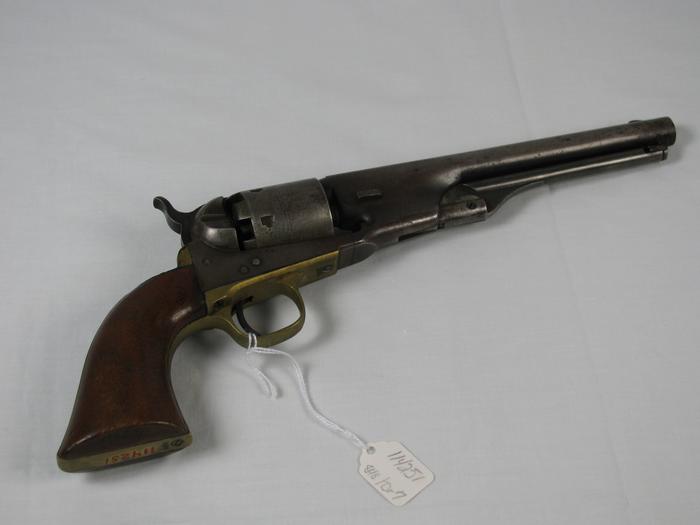Comments and Tags
Be the first to comment on this item!
Weapons
Weapons
Military and Veterans ➔ Revolver, Colt Model 1860 Army
Identifier:
114251Description:
Model 1860 Colt new style Army 6 shot revolver. "Colts Patent" engraved. "-Address Col. Sam L Colt New York U.S. America" stamped on barrel. "Colts Patent No 1589" stamped on cylinder. "1589" stamped 4 times on handle, barrel and trigger. "36CAL" stamped on trigger. Brass, Iron and Wood;"Colts Patent" engraved. "-Address Col. Sam L Colt New York U.S. America" stamped on barrel. "Colts Patent No 1589" stamped on cylinder. "1589" stamped 4 times on handle, barrel and trigger. "36CAL" stamped on trigger.;Acquired by seller's father-in-law several years prior to donation.;The Colt Model 1861 Navy cap & ball .36-caliber revolver was a six-shot, single-action percussion weapon produced by Colt's Manufacturing Company from 1861 until 1873. It incorporated the "creeping" or ratchet loading lever and round barrel of the .44-caliber Army Model of 1860 but had a barrel one half inch shorter, at 7.5 inches. Total production was 38,000 revolvers. Like its forerunner, the Colt 1851 Navy Revolver, it saw widespread use in the American Civil War and on the American Western frontier, though far fewer were produced. While similar in design to the Colt Army Model 1860, the lighter recoil of the 1861 Navy's .36 caliber was preferred by some cavalry soldiers. There were few variations of the Model 1861 Navy Colt. Approximately 100 of the first guns made had fluted cylinders with no cylinder scene. Another 100, made between the serial ranges of 11,000 and 14,000 were cut for a shoulder stock � the lower portion of the recoil shield was milled away and a fourth screw for the stock was added to the frame. With the exception of the first fifty or so of this model, all guns had a capping groove. A brass trigger guard and back strap, silver plated, were standard. During the Civil War its main competitor in England was the Adams self-cocking revolver. The Adams fired a .49 caliber bullet and did not require the shooter to pull the hammer back. Colt's revolver was more popular because Colt mass-produced his weapons while Adams' products were handmade by skilled artisans. In the United States, Colt's main rival was the Remington Model 1858 revolver. The Colt 1861 Navy typically was used with paper cartridges, that is, with a cartridge consisting of nitrated paper, a pre-measured black powder charge, and a bullet that was either a lead round ball or a lead conical bullet. The nitrated paper of the cartridge was completely consumed upon use, and the use of paper cartridges enabled faster re-loading. Alternatively, it was always possible to load with measured powder charges and lead round balls.ls.Date:
1862Materials:
Brass, Iron, WoodDimensions:
1" h 5.5" w 13" dCurrent Location Status:
In StorageCollection Tier:
Tier 2Source:
Museum PurchaseLinks:
http://en.wikipedia.org/wiki/Colt_M1861_NavyExhibit/Program:
Thank God for Michigan: Stories from the Civil War (June 6 2011 – March 29 2015)Thank God for Michigan was an exhibition developed by the GRPM to commemorate the sesquicentennial of the Civil War. The exhibit featured over 150 artifacts from the GRPM's collection and told the story of the Civil War through the lens of soldiers and civilians from Michigan.
Related Entities:
C. L. Kelsey (donor) Colt's Manufacturing, LLC (creator)Alternate names: Colt, Colt's Arms Company, Colt's Fire Arms Manufacturing Company, Colt's Patent Fire Arms Manufacturing Company, Colts Pt. F. A. Manufacturing Company, Samuel Colt's Arms Company
Samuel Colt asserted his vision for the revolver came to him in 1831, when, as a seventeen year old seaman, he observed that a ship's wheel had spokes that lined up with compass points. He then had a vision for a gun with a spinning cylinder that would lock into place with the simple action of cocking a hammer. He would patent the design in Great Britain in 1835, and the United States in 1836. The revolver design gave birth to the Peacemaker, "The Gun that Won the West." Colt would succeed the Peacemaker with the 1911, the Cobra Revolver and the M16 among others. The company remains in business, producing handguns over 180 years after the first revolver was patented.
Sources: https://www.americanheritage.com/army-colt#
https://www.colt.com/timeline
